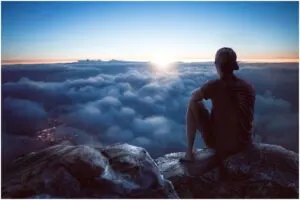Vajrapani (from Sanskrit Vajra, “thunderbolt” or “diamond” and pāṇi, lit. “in the hand”) is one of the earliest Bodhisattvas of Mahayana Buddhism.
He is the protector and guide of The Buddha and rose to symbolize The Buddha’s Power. As protector of the tantric teachings, he is sometimes referred to as the “Lord of the Secret.”
He was used extensively in Buddhist iconography as one of the three Protective deities surrounding The Buddha.
The Boddhisattva also has another name, Guhyapati (literally translates as ” Lord of Secrets”), because He is the one who transmits tantric knowledge, but also because the Vajra itself is secret insight.
Each of them symbolizes one of the Buddha’s virtues: Manjusri (the manifestation of all the Buddhas’ Wisdom), Avalokitesvara (the manifestation of all the Buddhas’ Compassion), and Vajrapani (the manifestation of all the Buddhas’ Power as well as the Power of all 5 Tathagathas).
Furthermore, he is one of the earliest Dharmapalas, and the only Buddhist Deity to be mentioned in the Pali Canon as well as be worshiped in the Shaolin Temple, Tibetan Buddhism, and even Pure Land Buddhism (where he is known as Mahasthamaprapta and is one of a Triad comprising Amitabha and Avalokiteshvara).
Manifestations can also be found in many Buddhist temples in Japan as Dharma Protectors called Nio. He is also associated with Acala, who is venerated as Fudo-Myo in Japan where he is serenaded as the holder of the Vajra.
In Shaolin traditions, he is not considered to be a standalone Bodhisattva, however. Instead, he is thought to be an aspect of the bodhisattva Guanyin due to a passage in the Lotus Sutra which states that Guanyin will take whatever form is conducive to spreading the dharma.
Later, Vajrapani was further confused with the Kimnaras due to the similarity of their Chinese names, and so in later times, they started to refer to him as Kimnara.
Iconography
He was first represented in India as the Hindu deity, Indra, the King of the demigods, and Lord of the Rains and War.
The similarity of the two, in their roles or protection and control of the weather, as well as their lightning bolt weapons created a connection to Vajrapani in India.
The Meaning Of Om Vajrapani Hum Mantra
On the popular level, he is the Bodhisattva who represents the power of all the buddhas, just as Avalokitesvara represents their great compassion, Manjusri their wisdom, and Tara their miraculous deeds.
For the yogi, he is a means of accomplishing fierce determination and symbolizes unrelenting effectiveness in the conquest of negativity.
According to the Pancaviṃsatisahasrika and Astasahasrikaprajnaparamitas, any Bodhisattva on the path to Buddhahood is eligible for Vajrapani’s protection, making them invincible to any attacks “by either men or ghosts.”
Chanting Benefits Of Vajrapani Mantra:
According to the Tantra of the Supreme Origination of Vajrapani:
“If the disciple renders one obeisance to him, he attains more merits than he would have secured through rendering numerous obeisances to myriads of Buddhas as many as the total grains of sands in ninety-two million Ganges Rivers… If he relies on Vajrapani as his Yidam Buddha and recites the Mantra, he will surely be protected by Vajrapani from all hindrances.
No demons can hurt him, all illness will be cured, his merits will be increased and prosperity augmented. All his wishes will be fulfilled. Thus, the benefits of practicing this ritual are beyond description, nothing can afflict those who practice it.”
Moreover, His empowerment is felt most amazingly by those devotees who are afraid, who lack strength and courage.
Image credit – @Getty
READ THIS NEXT: Jetsun Milarepa Mantra
Reference https://www.wildmind.org/mantras/figures/vajrapani
- About the Author
- Latest Posts
As a founder and chief author at InsightState.com, Bulgarea Candin helps readers on their spiritual journeys. His writings are designed to inspire creativity and personal growth, guiding readers on their journey to a more fulfilled and enlightened life.



Sunday 30th of August 2015
Now a days theas type of mantra is very useful for humans thanks